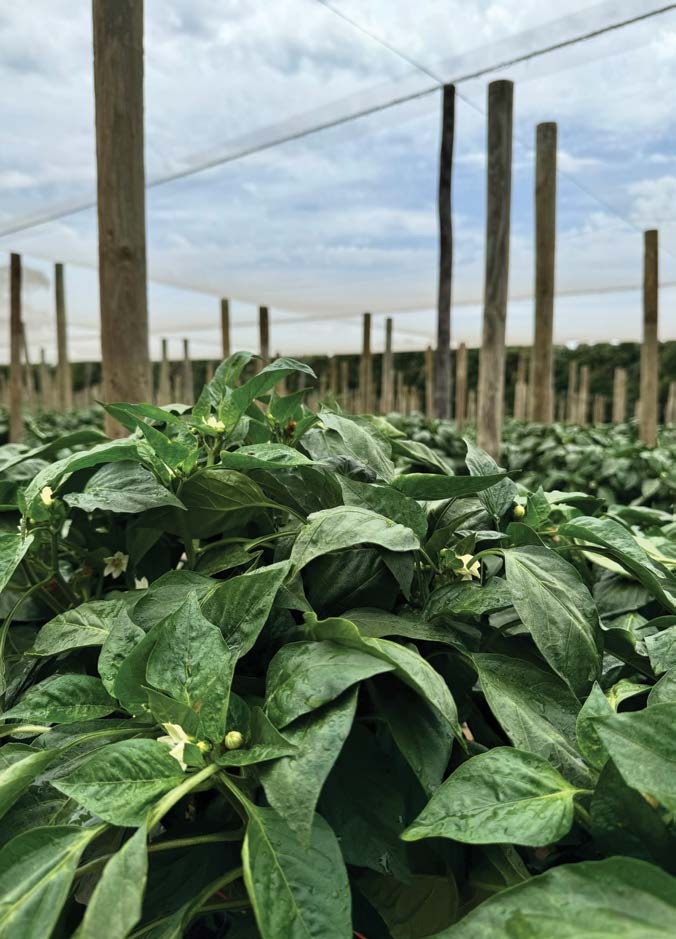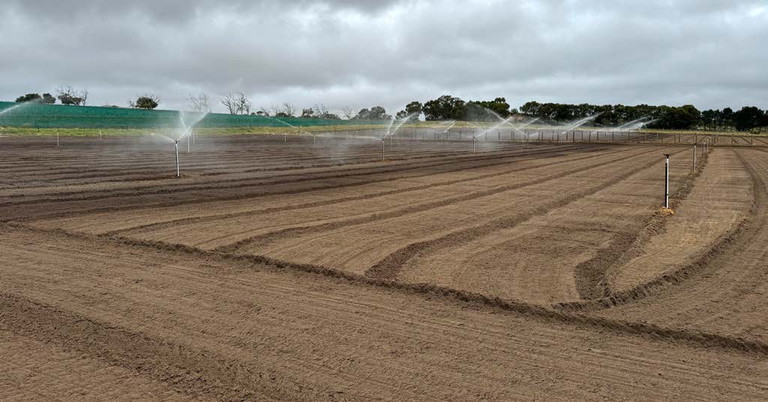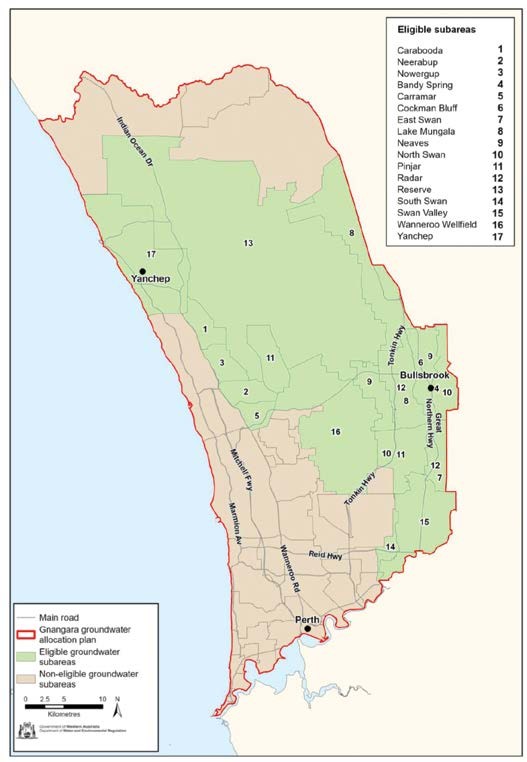BUSINESS grants
Gnangara growers
SECURE STATE
GOVERNMENT GRANTS
for water use efficiency
The WA Government is offering funding to eligible commercial horticultural businesses to support water use efficiency initiatives. This program assists groundwater users affected by the upcoming 10% reduction in water abstraction under the Gnangara Groundwater Allocation Plan, set to take effect in 2028.
Words Chi Nguyen, Regional Development Officer, vegetablesWA

Capsicums grow under permanent netting.
THE Horticulture Water Use Efficiency Grants Program (the Program) provides grants for implementing water-saving measures and includes a voucher program to engage water efficiency experts for tailored advice.
vegetablesWA Regional Development Officer Chi Nguyen has been actively updating growers on the Water Use Efficiency Grants Program, assisting them in accessing information and securing funding to enhance water management on their farms. Through Chi’s guidance and support, three farm businesses have successfully obtained grants to implement improved water use efficiency practices.
Project 1: Implementing permanent netting for water conservation
An assessment of capsicum water requirements revealed a seasonal need of 3ML/ha, meaning that the farm’s 5 hectares of cultivation would require 15ML per season. However, with a current water allocation of 13ML —set to reduce to 11.7ML in 2028 —a potential 3.3ML shortage could arise if the entire area is cultivated. Recognising this challenge, Ms T and Chi Nguyen evaluated the farm layout and existing irrigation systems to identify key areas where permanent netting could be strategically installed to maximise its benefits. Based on the farm’s vulnerability to water reductions and Chi Nguyen’s recommendation, Ms T applied for and was approved for a Water Use Efficiency Grant to implement permanent netting, a proven water-saving solution that will significantly enhance sustainability.
In consultation with netting specialists, the farm has procured QUAD Netting with a 20% shade factor and 29% UV block. The installation ensures optimal positioning above crops to maximise shade and UV protection.
Early results from the first capsicum crops grown under the netting structure have been promising, with fewer instances of sunburn and wind abrasion.
Most notably, water use has been reduced by up to 60%, demonstrating the netting’s effectiveness in improving water efficiency and supporting long-term farm resilience.
Project 2: Upgrading farm irrigation for improved water use efficiency
Mrs A sought to upgrade her farm’s irrigation system to enhance water distribution and efficiency. The project involved designing, and installing an automatic fixed sprinkler irrigation system, which would be connected to the existing bore pumping system. The upgrade focused on improving distribution uniformity, ensuring even water coverage across the entire field.

The project included designing a more efficient irrigation system, upgrading the bore system, installing an automated 52-station irrigation controller, laying new pipelines, upgrading solenoid valves, and installing high-efficiency sprinklers to ensure even water distribution. Before speaking with Chi Nguyen, Mrs A was unaware of the Water Use Efficiency Grant. With Chi’s guidance, she successfully applied for and secured the grant to fund the irrigation system upgrade.
The new system has already shown positive results, particularly during this year’s hotter summer, with fewer instances of heat stress in tomato crops. The sprinkler irrigation not only ensures even moisture distribution but also helps cool plants during extreme temperatures, reducing heat stress and improving fruit quality.
Project 3: Transition to protected cropping – greenhouses (ongoing)
Chi Nguyen visited the farm last year and learned that Mr D planned to build a greenhouse to diversify his produce line and improve water management. The project involves installing a durable frame structure based on approved engineering plans, covering the roof and walls with 200-micron plastic for UV protection and insulation, constructing side walls with insect shade material to control pests and provide shading, and installing a solar-powered rolling system for adjustable temperature and ventilation control.
After speaking with Chi Nguyen, Mr D learned about the Water Use Efficiency Grant. He applied and successfully received funding approval for the greenhouse construction.
Growing crops in a greenhouse significantly enhances water use efficiency by creating an environment that reduces exposure to sunlight and wind.
The enclosed space maintains higher humidity levels, minimising water loss and optimising irrigation. Greenhouses also enable year-round production, maximising water use across multiple crop cycles instead of just one. This approach ensures that every drop of water contributes more effectively to crop growth, leading to higher yields and improved sustainability. The greenhouse is currently under construction and is expected to be completed this year.
Gnangara Horticulture Water Use Efficiency Grants Program
The Grants Program will close on 30 June 2025, or when funds are fully committed. To be eligible for funding, applicants must be commercial producers with a water licence and the right to take and use water for an established horticultural business in one of the eligible Gnangara groundwater allocation plan areas (see Figure 1). They must also conduct business on land identified as eligible and hold a licensed groundwater allocation subject to a 10% reduction from 2028 under the 2022 Gnangara Groundwater Allocation Plan.
Additionally, applicants must demonstrate that they meet the eligibility criteria outlined in the Horticulture Water Use Efficiency Grants Program Guidelines.
If this program aligns with your business needs and you meet all eligibility criteria, apply now! The program will close on 30 June 2025, or when funds are fully committed.

FIGURE 1: Gnangara map of eligible sub areas.
Source: DPIRD